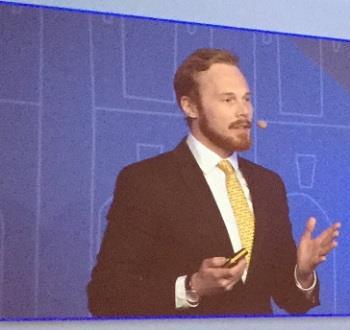New sources of global capital injected €6.4 bn into European real estate in the first three months of 2017, delegates heard at the annual Inrev conference in Berlin earlier this week.

Tom Leahy (pictured), senior director, EMEA Analytics at RCA told the conference that he saw no signs of a major slowdown in appetite for property as an investment class despite ongoing political risks and evidence of a late real estate market cycle. All in all, some $855 bn (€804 bn) was pumped into real estate globally last year, he added. ‘This marks a drop off since 2015, but there hasn't been a big fall-away. Investors are still saying they want more not less real estate.'
A notable exception in Europe in term of investment volume last year was the UK which reported a 40% decline. However, the softening was already under way before the Brexit vote and other countries, most notably Spain and Sweden, saw significant growth, Leahy said.
For the first time, Asian investment took the number 1 spot in Europe and globally last year, replacing their US peers. South Koreans were particularly active in Europe in 2016, with investments in the Benelux, Austria and Germany.
Tightening yields
Leahy added that Asian capital tends to target prime locations and that they were prepared to pay initial yields trending towards 5%. The decline in US capital could be related to the tightening pricing levels, Leahy added. 'US investors are finding it more difficult to find the right stock to drive returns of between 6% and 6.5%. That's a difference of 150 basis points. We’re also seeing some Asian investors pricing out domestic money and some other money from around Europe.'
Leahy pointed out that private equity firms have become net sellers of European real estate in 2016 after five years of being net buyers. 'That's also an indication of where pricing is in the market.'
Tightening yields in prime markets are pushing some investors into secondary or even tertiary markets, he added, pointing to cities such as Dublin, Helsinki, Prague and Nuremberg.
Late cyclical
In terms of new Asian capital sources, Japanese investors are now gearing up to spend more on real estate globally, Tetsuya Hasegawa, senior vice president of Japan's Sumitomo Mitsui Banking Corporation, confirmed during a panel discussion entitled Crossing continents: global investor insights.
Japanese real estate investment is still in the preliminary stages, Hasegawa confirmed, but he dismissed concerns that the Japanese might be coming too late to the party. 'We're looking at long-term investments…We can afford to ignore the cycle,' he noted.
His own firm is seeking to spend 15% of its real estate allocation overseas and that figure will be divided equally among the three main regions – Europe, the US and Asia – with a target IRR of 8%. 'We will need to add some spice to enhance returns,' he conceded.
Two segments that Hasegawa singled out as being potentially attractive were student housing and real estate debt.
Outlook is good
Commenting on the downward pressure on yields, fellow-panellist Francois Traush, CEO of Allianz Real Estate, said he still feels good about Europe. Occupancy levels and rental growth can mitigate very low cap rates, he pointed out. 'There has always been political uncertainty, but we live in a time that the economic outlook has never been so good in three continents. Even in France the outlook is extraordinarily good.'
While capital preservation is a key motive for Asian investors coming to Europe, European investors like Allianz go to Asia and the US for growth, Trausch said. And not without success: in the past 10 years, Allianz has built up a €50 bn portfolio worldwide and it continues to expand by some €6 bn a year. Of the total portfolio, approximately 70% - or €35 bn - is equity and 30% - or €15 bn – comprises of debt. Allianz is very keen on debt, Trausch said: 'We like it anytime, anywhere and any size but not at any price!'
Judy McMahon, portfolio manager real Assets at US investor UPS Investments, said her firm had also become a net seller in 2016. While there are some parallels now with the boom year of 2006, McMahon pointed out that there were also key differences. In 2006 the spreads between real estate yields and government bonds was 'ridiculous', she said, pointing to a difference of just 70 basis points. 'Spreads are now 300 bps across the world and 350 bps in the US. That’s quite a different situation.'
In addition, there are now considerable constraints on growth of both supply and debt combined with slow but gradual GDP growth. But, she warned, 'there's less runway before us than behind us now. It’s time to be careful.’










